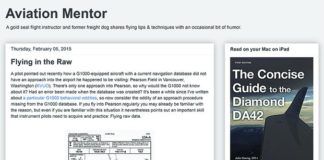Back in 1984, IFR magazine debuted as a full-color, glossy magazine. It dove deep into the minutia of instrument flying with a practical stance and acerbic wit, while respecting it for the high art that it truly is. The color didn’t last long—too expensive to print—but the mission remained. In the ensuing 25 years, we’ve been exploring not just the chicken-scratch details of IFR, but the shade of the flecks in the chicken scratch.

Now you can examine those flecks in color once again.
The move to color comes from the confluence of decreased costs to print full-color with an increased need for color in these pages. Even just 10 years ago, instrument flying was a world of black-and-white approach plates guiding us through the miasma of grey skies. Yeah, there was some blue and green on en route charts and red at the far end of the runway, but our recurring IFR battle cry of “Fly the black line” was really about black lines.
Now that black line coincides with a magenta one on the GPS for tens of thousands of pilots. Explaining a G1000 screen means understanding not just that magenta, but the meaning of something being in green or cyan versus white. Interpreting cockpit NEXRAD is almost entirely an exercise in color. (Don’t get me started on how long it can take to make the greens, yellows and reds of a NEXRAD image remotely understandable on a black-and-white page). Color matters when dissecting online weather, using terrain warning systems on circling approaches, or revamping your scan to best use a glass panel. Color has even made it onto the approach plates.
The simple fact is that technology in the FBO and cockpit has brought color and we can’t do this job as well as we want to without opening up a new box of crayons. But with any new tool, there’s the temptation to try and make it do too much. There’s the risk of getting distracted from that core mission of practical, proficient flying. We don’t need no stinkin’ color to talk about negotiating with ATC or finding places where the regs have wiggle room. (Although they do involve several shades of gray.) We promise to use our new toys to first deliver better content, and second create something that’s more enjoyable to read. If you think we’re wandering too far, don’t hesitate to let us know.
When it comes to making the magazine better in its new format, a hearty call of thanks is in order for Paul Bertorelli and Judi Crouse. Without their guidance, this conversion couldn’t have happened at all, let alone on such short notice. Thanks as well to John McCloy for the updated logo.
Paul Bertorelli was an IFR editor several years back (you know, way back in the black-and-white days). Sitting on a commercial flight one day, he struck up a conversation with the woman sitting next to him. She asked what he did for work and he explained he edited a magazine about flying in the clouds.
After a pause, she said, “That must be really hard to illustrate.”
Well, she was right. But we’re hoping it just got a bit easier.
—Jeff Van West





